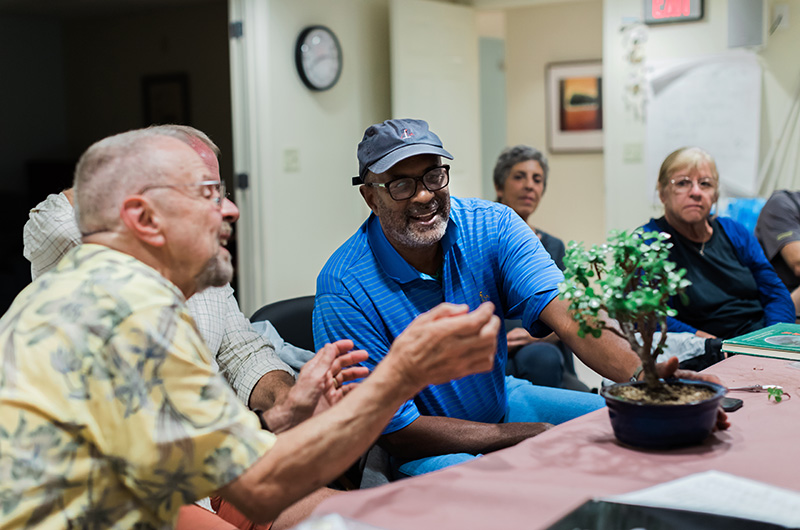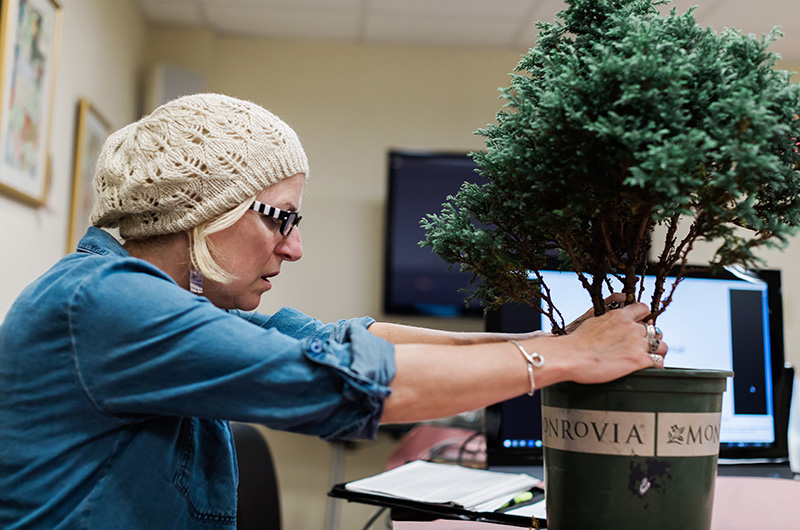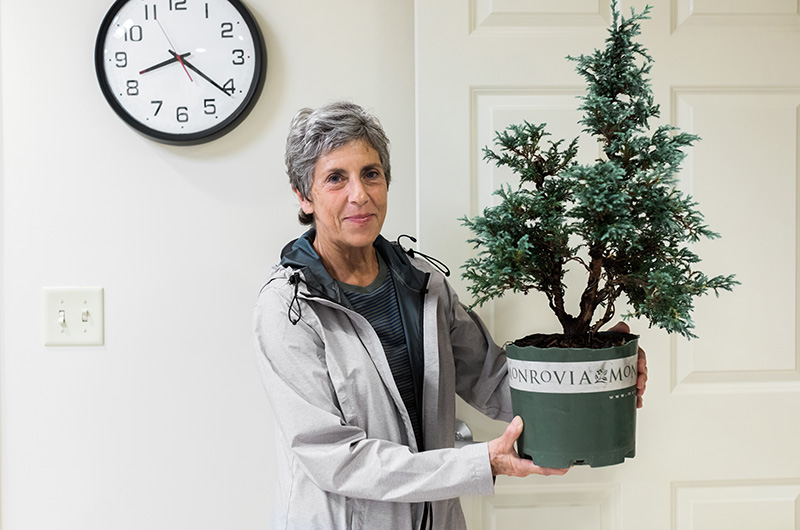Bonsai, the term for traditional Japanese miniature trees, can come in many forms. On Martha’s Vineyard, so, too, can their owners.
Every third Tuesday of the month, a forest of them as varied and ageless as the tiny junipers, jades and jasmines in their possession gather under the fluorescent lights of the Vineyard Center for Living to laugh, learn, lament and laugh some more as part of the Martha’s Vineyard bonsai club. They’ve met for almost 10 years now, and while their trees haven’t grown much at all — that’s kind of the point — something far more important has.
“Well, the bonsai club is sort of our little community,” said de facto club president and bonsai maestro Don Sibley. “It grew out of my appreciation for Japanese gardening, and of course, the fact that here on the Island for the winter you need things to do.”
Mr. Sibley, a Harvard-educated artist with the temperment of a monk, has over 30 bonsai trees on his property in Vineyard Haven. Stationed in Japan during his U.S. Army years, the now-retired professor gained an appreciation for Japanese gardening, and, in particular, bonsai, nearly three decades ago. Since then, he’s planted his own roots, both literally and figuratively, on the Island, serving as steward of Mytoi Gardens on Chappaquiddick and cultivating a community of avid bonsai lovers that extend far beyond the serene ponds, maples, gravel designs and tiny trees that adorn his own backyard.
“Don’s the Jedi,” said Dan Whiting, a club member and bonsai fanatic who has studied under Mr. Sibley’s tutelage for the past decade or so. “The first time I walked up to his house, I saw those trees and garden, and I was like, whoa.”
Turning 40 next week, Mr. Whiting is young by bonsai owner (and bonsai tree) standards, but since he starting pruning his first juniper bush eight years ago, he’s become one of the club’s most dedicated members.
“I pulled one of those flyers off at the fair one year, and it was stuck to my fridge for probably three years before I went,” Mr. Whiting said. “I just find it really interesting. The club is full of smart, eccentric people. They’re characters, but they’re really smart characters. Every time I go to a meeting, I come back feeling like, oh, I just want to go home and play with my trees.”
Along with Mr. Sibley and Mr. Whiting, the club has 10 or so regulars who make it to Breakdown Lane every month, often attending with their bonsai in tow. Although most fit the “retirees with bonsai trees” moniker, they count naturalists, activists, doctors and contractors among their ranks. And at the meeting last Tuesday, each one expressed a different reason for obsessing over the miniaturized sculptures that are far more “pet” than “house plant.”
“We got involved when we went to the Ag display, and put it in the back of our mind,” said Rick Bailey. “And Janet my wife was given a bonsai for a birthday gift, and she thought, hey, maybe we should check out that bonsai club. That was five years ago.”
Along with bonsai, the pair now have administrative roles within the club. “I missed a meeting and became treasurer,” Ms. Bailey explained.
Others had even more circuitous routes to the bonsai club.
“The reason I got involved with bonsai was that we had a dog named Bonnie, and our children called her Bonsai,” said Susan Wilson. “And after she passed they thought it would be a nice memorial to give me a bonsai. Here I was finally without a pet, and they give me this thing that might as well have ‘never leave alone and hire only trained sitters’ written on the front of it.”
Ms. Wilson also happened to be the meeting’s designated presenter. In the past, other members have given brief talks on potting, watering and mosses. Eric (Ver-non) Turner, whose middle name is the subject of a running joke within the club, presented a “deep history of the bonsai,” going all the way back to its origins with traditional Chinese penjing trees.
In Tuesday’s session, Ms. Wilson discussed bonsai forms, describing the differences between Chokkan, or straight form, and Moyogi, or curved form, or as club member Caroline Evans called it, “scoliosis.”
Ms. Wilson continued with broom form, slanting form, windswept form (where all the branches go in one direction) cascade form, candelabra, and literati, where the bonsai remains bare until the very top of the tree. When Ms. Wilson mentioned that the ancient guidelines of bonsai regulate that the trees always have odd-numbered trunks, and that bonsai forests always have an odd number of trees, the rapt audience seemed to nod in both agreement and respect for the time-honored practice.
“When you design a forest, it all goes back to what’s in nature,” Mr. Whiting said. “We’re trying to mimic nature, but with art as well. How many petals are on a leaf, how many branches on a trunk? Once you start noticing it, you can’t help but make it a part of your life. It’s like building houses.”
Mr. Whiting does not use the comparison lightly — he is a contractor by trade. At his own home in Oak Bluffs, he has built a winterized shelter for his bonsai that includes a thermostat, infrared heating lamps and a glass storm door.
“There’s a switch inside the house so I can just turn the light on and check on them without having to go outside,” he said. “I’m having fun with it, really. And keeping them alive.”
When Mr. Whiting built the pond for his Japanese garden, he added all-natural water features to his contracting repertoire. Since then, he’s built three swimming pools on the Island that use the microbiology of soil and plants to filter water rather than chlorine. He credits his interest in bonsai as a major inspiration for his career.
“It’s all hand in hand,” Mr. Whiting said. “The Japanese garden has led me down this path that I love.”
Back at the meeting, Mr. Sibley announced the winners of the Agricultural Fair’s “people’s choice awards.”
“We’ve trained a whole generation of voters,” he said. “They respond to trees with great personalities.”
Garnering 42 votes, first prize went to Mr. Whiting’s olive tree, whose massive, craggy trunk looked more like a cross-sectioned ant-farm than a living, breathing bonsai. Mr. Sibley was too humble to say that his own Japanese maple actually received over 100 votes.
“So I didn’t even win?” Mr. Whiting said upon learning this.
“Well, we decided a while ago that I would be in the ‘professional’ category,” Mr. Sibley replied.
Even so, Mr. Whiting was proud of his performance and how far his “practice” has come under Obi-Wan, ehem, Mr. Sibley’s guidance. Eight years ago, a Japanese garden in Mr. Whiting’s own backyard was an unachievable dream. Now it’s a reality.
“I have friends come over and the look on their face is like how I felt when I went to Don’s house for the first time,” Mr. Whiting said. “It’s funny because people are always like, oh, do you have to prune them everyday? And no, not really, you just have to pay attention to them. For me, it’s a way to slow the busy-ness of the day, kind of zoom in to kind of a micro world, just check on it. And when you do that, it’s a way to become closer to nature, and also closer to yourself.”











Comments (1)
Comments
Comment policy »